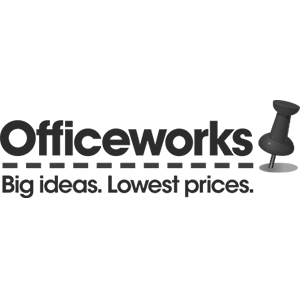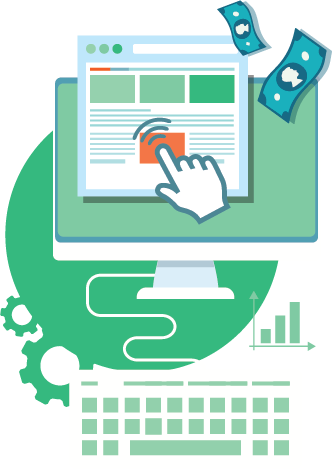
This guide is to help you convince resistant clients to appreciate the value of A/B testing, so you can institute a testing program, bringing about optimal gains and conversions.
Here’s the step-by-step process you can follow, with a template at the end, so you can convince resistant clients to test.
Digging into the data, through an analytics platform, like Google Analytics, and/or a visual data tool, like Crazy Egg’s heatmapping data, conduct a cursory analysis to determine the areas of optimization for your client’s site.
As an example, let’s imagine heatmapping data, combined with Google Analytics, shows visitors are taking action to filter and search for certain products, but aren’t heavily using the search bar.
Perhaps heatmapping data looks something like this:

With this data in hand, your hypothesis may be something to the effect of: enlarging the size of the search bar — to make it more visually prominent — will increase searches, leading to more product order conversions.
You want to test this hypothesis to optimize your client’s website, but your client is resistant to testing.
Why would the client resist?
Maybe the C-suite doesn’t understand testing, and doesn’t think it’s worth the time or resources.
Maybe the IT department is already too tasked, and doesn’t want to take on more.
Maybe the company doesn’t know where to start with testing, and feels too overwhelmed to begin — even if you’re going to help.
Or, maybe the company thinks, yeah, but we’re different, testing won’t help us – even if it’s helped other organizations, like them.
If your client is resistant, that’s perfect! It’s your opportunity to shine. Here’s how:
Yes, every client, and every industry, is different. But, the likelihood your client has similar, direct competitors is very high.
As your first step, start with a benchmark visual comparison of your client’s competitors’ website.
For example, let’s say your client is Amazon (wouldn’t that be nice!) and you want to convince them about the value of testing.
But, they’re resistant to the idea. (Clearly this is a hypothetical example. Amazon undoubtably has a terrific testing army behind its highly optimized site.)
By conducting a visual benchmark, you can see what other sites are doing, and get ideas for testing and optimizing your client’s site.
If you don’t know where, or how, to look for competitors in your client’s industry, checkout Owler.
For free, you can search by your client’s company name, or URL. And, get instant stats about the company, including top competitors, or alternatives.
As an example, here’s what comes up for Amazon:

Now, you can go to these other sites and reference what they’re doing with their search bars, compared to what your client is doing.
Let’s take a look:
Amazon

Walmart
Smaller search box, no filter, but text prompt to encourage user to type in search terms.

Alibaba
Combines elements of both Amazon’s and Walmart’s search bar. Has a dropdown filter, a text prompt, a big “search box”, and a “new” search by image feature, where you can upload images and search for them.

Let’s say you have a hunch Alibaba’s search bar is performing well. And, you really like the features it offers.
It’s given you inspiration.
You can now go back to your client, Amazon, with something concrete.
You can suggest, they test whether adding a “what are you looking for. . .” prompt helps optimize conversions.
But, remember. Your client is already hesitant about testing. They might pushback. Just because you show them other sites doing things potentially better, doesn’t mean anything.
You need data.
Here’s your opportunity to leverage GuessTheTest’s growing library of archived tests.
Simply filter for related tests, view the case studies, and use the case study findings to support your hypothesis. Going with the search bar theme, here’s two real-life case studies that show the optimal format for a search bar:

Reviewing the results, simply copy and paste the short summary, from the real-life data to show your client the effect of testing this element on their website.
Doing so will provide a data-driven approach, helping prove to your client just how much they stand to loose, if they don’t test. And, just how much they can potentially gain, if they do test!
You can even involve the client, and get them to guess which test they think won! For example, ask them: did the single or multi-line search box work best:

Even after seeing real-life helping prove your idea, the client still might push back. Be prepared.
It’s prudent to tell them there’s no guarantee making a change, like modifying the search bar, will help.
But, that’s why we test.
Testing mitigates risk.
When only 50% of traffic sees one version, that means that other 50% doesn’t. So, if the version we’re testing underperforms, we’re not loosing our shirts. Only half the viewers see that version. And, we’re only exposing it to them for a limited time.
But, if the suggested version does outperform, the opportunity to increase ROI is enormous!
If the company can increase the number of people completing transactions – because more people are finding the products they’re looking for through an optimized search bar – the gains can be incredible.
As an example, let’s say the client’s website has an average of 10,000 visitors, per day. And, we increase conversions by 1%. Imagine the average value of a conversion is $100.
As this chart shows, we’ve just helped the client increase daily revenue by $10,000!

And, that’s a conservative estimate! Ideally, you’ll be wanting to aim to lift conversions by at least 3-5%.
As the client should clearly see, the additional revenue is well worth the cost and risk of testing.
You can use this conversion calculator to work out the exact figures for your client.
Armed with the data, use the above steps to create a short report, or presentation that shows your client exactly what to test and why doing so is SO valuable.
Need a template you can use where you have simply substitute in your information — without having to do all the hard work?
GuessTheTest has created a plug-and-play template for you!
Simply download this template (available to Pro Members only) fill in your information, and send off to the client. Then watch those testing dollars roll in.
Hope this guide is helpful for you. Please share your thoughts and comments in the section below.
A primer explaining the 4 different types of tests you can run, what they mean, and how you can use each to improve your competitive testing advantage.
One of the most debated testing topics is how large does my sample size need to be to get trustworthy test results? Some argue samples of more than 120,000 visitors per variant are needed to begin to see trustworthy test results. Ishan Goel of VWO disagrees. What does he think is needed to get trustworthy test results? Listen to this webinar recording to find out.
To get users clicking your content, which format works best: buttons or links. A series of 8 real-life A/B tests suggests one format consistently outperforms. Can you guess which version wins? Checkout the mini meta analysis to find out.













